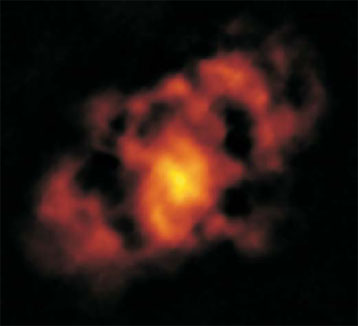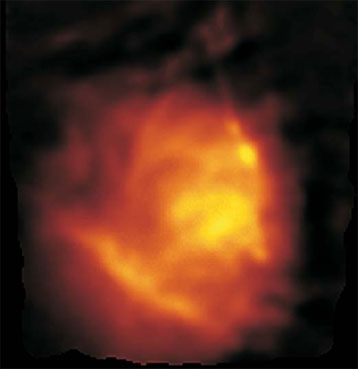NRAO eNews
October 2008 • Vol. 1, Iss. 5
- The Expansion of Supernova Remnant G21.5–0.9: Is PSR J1833–1034 the Youngest Pulsar?
- Discovery of a Small Group Driving the Evolution of an Edge-On Spiral Galaxy
- Cosmic Rays and the Magnetic Field in the Nearby Starburst Galaxy NGC 253
- Neutral Hydrogen Clouds in the M81/M82 Group
- ALMA Project Progress
- North American ALMA Science Center
- The ALMA Spectral Line Catalog
- The Birth and Feedback of Massive Stars, Within and Beyond the Galaxy: The NAASC Science Workshop for 2008
- Current Status
- VLA Configuration Schedule, Proposals, and Scheduling
- VLBA and HSA Proposals and Scheduling
- Global cm VLBI Proposals
- VLA and EVLA Spectral Line Observations Below 1200 MHz
- Status of Observing with the Transition Array
- VLBA Sensitivity Upgrade Project
- First 3mm Science Observations with the GBT and MUSTANG Call for Proposals
- The GBT Dynamic Scheduling System Update
- Progress on the Ka-Band Focal Plane Array for the GBT
- Opportunities for University-Led Technical Development Projects in Green Bank
- New NRAO Website Debuts
- The NRAO at the American Astronomical Society and American Association for the Advancement of Science Meetings
- Call for GBT Shared-Risk MUSTANG Proposals
- Large Proposals to Use NRAO Telescopes
- Chris Carilli Appointed Observatory Chief Scientist
- Eleventh Synthesis Imaging Workshop
- 2008 Grote Reber Medal Awarded to Sandy Weinreb
- NRAO Participates in the BEYA Conference
- NRAO Business Managers Meet in Chile
- NRAO Library News
- Past Issues
- Contact the Editor
- Subscribe
- More Information
NRAO Newsletter • April 2008 • Issue 115
First 3mm Science Observations with the GBT and MUSTANG Call for Proposals
Figure 1. 90 GHz image of the Crab SNR made with MUSTANG on the GBT. The size of the image is approximately 8'×8'; MUSTANG’s instantaneous field of view is 32"×32". 
Figure 2. Map of the Orion A region made with MUSTANG, the GBT’s 90 GHz bolometer array. The MUSTANG bolometer camera was installed on the GBT in early December 2007 for a second commissioning run, and given the success of the run, to execute the refereed early science proposal submitted by the team for trimester 08A. The performance and robustness of the instrument on the telescope has thus far been outstanding. Substantial progress has also been made in the data analysis algorithms (principally in the OBIT package). As an illustration, the accompanying Figure 1 shows a 90 GHz map of the Crab supernova remnant. Figure 2 shows a map of the Orion A region. So far just over 50 square arcminutes of Orion have been imaged to a noise level of about 2 mJy RMS. MUSTANG detects both free-free emission from the nebular gas ionized by the O stars in the Trapezium and thermal dust emission from the dense molecular cloud OMC 1 in the background. Combined with other data sets of about the same spatial resolution (e.g. VLA and/or GBT continuum for the free-free and SCUBA 450 and 850 microns for the thermal dust emission), spectral decomposition of the MUSTANG maps will be used to study the dust emissivity as a function of the wavelength and its possible variation through this region. As reported previously, MUSTANG (the Multiplexed SQUID TES Array at Ninety Gigahertz) achieved first light in engineering observations on the GBT in September 2006. The MUSTANG receiver was built by a collaboration that included the University of Pennsylvania, NRAO, GSFC, NIST, and Cardiff University. The basic functionality of all aspects of the system and interfaces (optics, cryogenics, detectors, SQUID multiplexers, data acquisition and control software, etc.) was demonstrated in situ. In the process the observation and data analysis procedures were improved considerably. The team confronted a number of challenges during the run, chief amongst them a previously known source of significant 1/f noise in the receiver. In spring 2007 this noise was determined to be caused by low-level vibrations in the pulse tube cooler—which provides the first two stages of cryogenic cooling—and successfully mitigated by redesigning the cold heat straps and soft-mounting the pulse tube at 300 K. As a result of this work the sensitivity of the instrument is now approximately five times what it was in fall 2006. Other work over the course of the spring and summer included: procurement and installation of a 20 GHz bandpass filter, replacing the 8 GHz filter used in initial observations and yielding a further factor of 2.5 in sensitivity (since the instrument is receiver noise limited); cleaning and rebuilding the pulse tube cooler and procuring a spare; and installing faster heat switches and more powerful heaters to reduce cycle times. Modifications were also made in the interface of the instrument to the GBT’s 1000 footlong helium supply lines and in helium-fill procedures. In the fall, work commenced in Green Bank on the task of migrating the Java software used for early data acquisition and control over to GB’s Monitor and Control framework, YGOR. In February 2008 tests the YGOR manager was successfully used to fully configure MUSTANG and to acquire and record the data to a FITS file. Further work on users interfaces, tuning algorithms, and observing and data analysis software will take place over the summer, leading to a final systems-commissioning run in the upcoming winter. This work, along with ongoing efforts by the PTCS team to improve and characterize the antenna, are aimed at moving GBT 3mm observations from the shared-risk category into a general user mode. Based on these promising first results from the receiver, proposals for shared-risk science observations will be accepted in the June 1 call (more details). Click here for Information on the expected performance of the instrument. Accepted proposals should be carried out in collaboration with the instrument team, and proposers are encouraged to consult the instrument team concerning questions of technical feasibility prior to submission of proposals. Contact Brian Mason (bmason@nrao.edu) with further inquiries. B. S. Mason (NRAO), S. Dicker (UPenn) and MUSTANG collaboration (UPenn, NRAO, NASA-GSFC, NIST, Cardiff University) |
